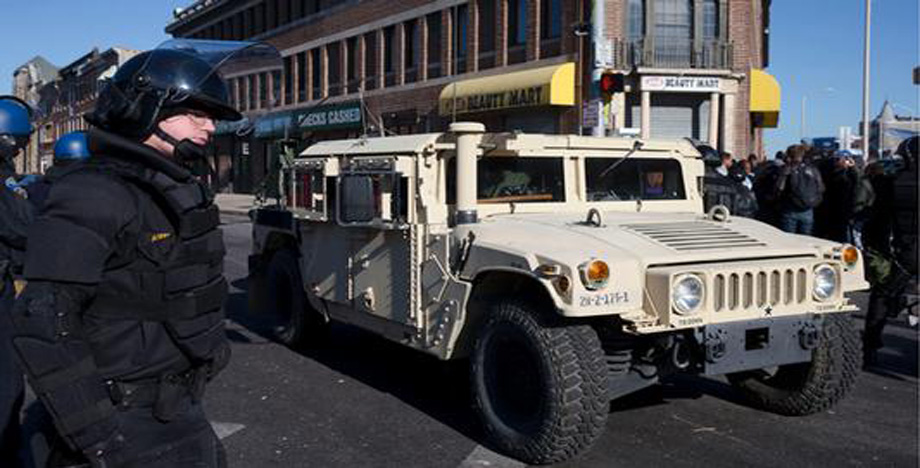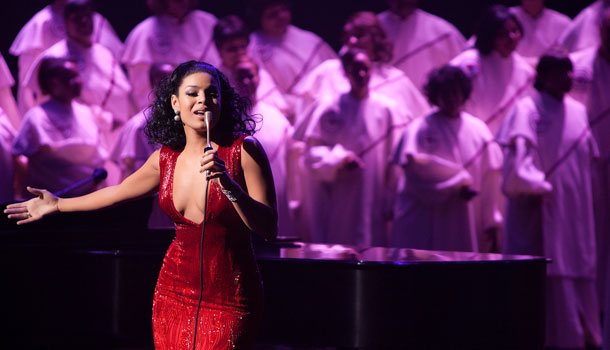
National Guardsmen fanned out across the city, police with riot shields blocked streets, and firefighters doused smoldering blazes Tuesday after looting and arson erupted in Baltimore following the funeral of a black man who died in police custody.
It was the first time the National Guard was called in to quell unrest in Baltimore since 1968, when some of the same neighborhoods were convulsed by violence after the assassination of the Rev. Martin Luther King Jr.
The rioting started in West Baltimore on Monday afternoon — within a mile of where Freddie Gray, 25, was arrested and placed into a police van earlier this month — and by midnight had spread to East Baltimore and neighborhoods close to downtown and near the baseball stadium. The streets were calm Tuesday morning.
At least 15 officers were hurt, including six who were hospitalized, police said. There were 144 vehicle fires, 15 structure fires and nearly 200 arrests, the mayor’s office said.
Gray’s death under still-mysterious circumstances has become the latest flashpoint in the nation’s debate over the use of police force against black men.
The rioting was the worst such violence in the U.S. since the turbulent protests that broke out over the death of Michael Brown, the unarmed black 18-year-old who was shot by a white police officer in Ferguson, Missouri, last summer.
Aerial footage Tuesday morning from Baltimore station WJZ-TV showed a firefighter spraying the burned-out shell of a large building.
The city was under a 10 p.m.-to-5 a.m. curfew beginning Tuesday, and all Baltimore public schools were closed.
“I understand anger, but what we’re seeing isn’t anger,” Mayor Stephanie Rawlings-Blake lamented. “It’s disruption of a community. The same community they say they care about, they’re destroying. You can’t have it both ways.”
State and local authorities pledged to restore order but found themselves responding to questions about whether their initial response had been adequate.
Rawlings-Blake waited hours to ask the governor to declare a state of emergency, and the governor hinted she should have come to him earlier.
“We were all in the command center in the second floor of the state House in constant communication, and we were trying to get in touch with the mayor for quite some time,” Gov. Larry Hogan said at a Monday evening news conference. “She finally made that call, and we immediately took action.”
Asked if the mayor should have called for help sooner, however, Hogan replied that he didn’t want to question what Baltimore officials were doing: “They’re all under tremendous stress. We’re all on one team.”
Rawlings-Blake said officials believed they had gotten the unrest under control, “and I think it would have been inappropriate to bring in the National Guard when we had it under control.”
The rioters set police cars and buildings on fire, looted a mall and liquor stores and threw rocks, bottles and bricks at police in riot gear. Police responded occasionally with pepper spray.
“They just outnumbered us and outflanked us,” Baltimore Police Commissioner Anthony Batts said. “We needed to have more resources out there.”
The governor said he was temporarily moving his office from Annapolis to Baltimore on Tuesday.
Attorney General Loretta Lynch, in her first day on the job Momday, said she would send Justice Department officials to the city in coming days.
Maj. Gen. Linda Singh, adjutant general of the Maryland National Guard, said up to 5,000 troops would be available for Baltimore’s streets.
“We are going to be out in massive force, and that just means basically that we are going to be patrolling the streets and out to ensure that we are protecting property,” Singh said.
Col. William Pallozzi, superintendent of the state police, said a request for up to 500 additional law enforcement personnel in Maryland had been sent. Pallozzi added that the state is putting out a request for up to 5,000 more law enforcement personnel from around the mid-Atlantic region.
Maryland Rep. Elijah Cummings and about 200 others, including ministers, tried unsuccessfully to quell the violence at one point Monday night, marching arm-in-arm through a neighborhood littered with broken glass, flattened aluminum cans and other debris.
As they got close to a line of police officers, the marchers went down on their knees. They then rose to their feet and walked until they were face-to-face with the police officers, who were in a tight formation and wearing riot gear.
But the violence continued, with looters later setting a liquor store on fire and throwing cinderblocks at firetrucks as firefighters labored to put out the blazes.
Gray was arrested April 12 after running away at the sight of police, authorities said. He was held down, handcuffed and loaded into a van. Leg cuffs were put on him when he became irate inside. He died of a spinal cord injury a week later.
Authorities said they are still investigating how and when he suffered the injury — during the arrest or while he was in the police van, where authorities say he was riding without being belted in, a violation of department policy.
Six officers have been suspended with pay while the investigation continues.
The riot came amid a national furor over the deaths of several black men at the hands of police — from the Brown case in Ferguson to the chokehold death of Eric Garner in New York and the shooting of Walter Scott in North Charleston, South Carolina.
While they are angry about what happened to Gray, his family said riots are not the answer.
“I think the violence is wrong,” Gray’s twin sister, Fredericka Gray, said late Monday. “I don’t like it at all.”
The attorney for Gray’s family, Billy Murphy, said the family had hoped to organize a peace march later in the week.


